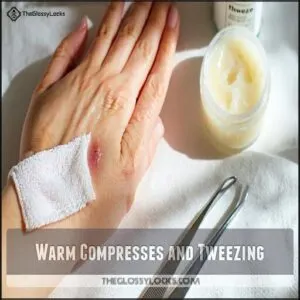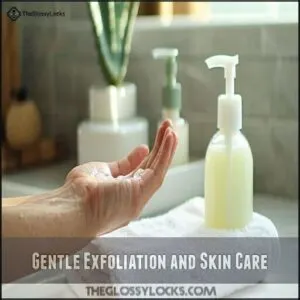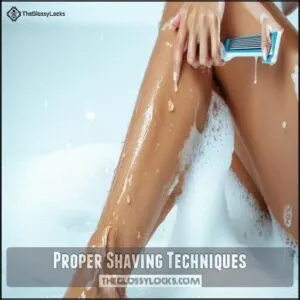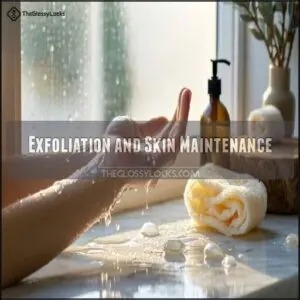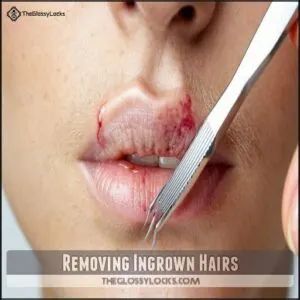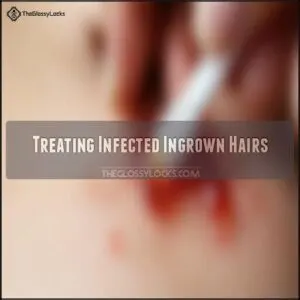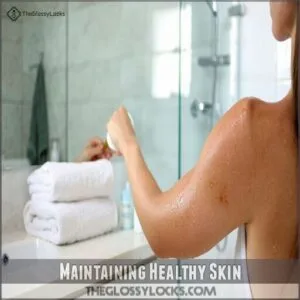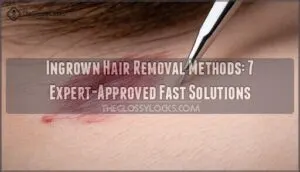This site is supported by our readers. We may earn a commission, at no cost to you, if you purchase through links.
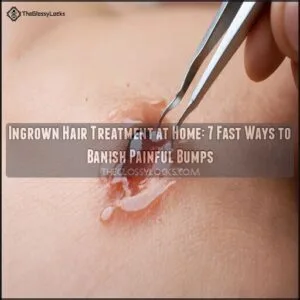 If you’re battling an ingrown hair, start with a warm compress to soften the area and reduce swelling—it’s like giving your skin a little hug.
If you’re battling an ingrown hair, start with a warm compress to soften the area and reduce swelling—it’s like giving your skin a little hug.
Gently exfoliate with a washcloth or scrub to free trapped hairs, but don’t go overboard; your skin’s not a piece of sandpaper.
Avoid picking or squeezing, since that can invite infection. If the hair’s visible, use sterilized tweezers to carefully remove it.
Keep the area clean and moisturized to prevent more bumps. Tight clothes? Ditch those—they’re part of the problem.
Stay tuned for tips on prevention that’ll keep your skin smooth and stress-free, with a focus on avoiding further infection.
Table Of Contents
Key Takeaways
- Use warm compresses to soften the skin and gently exfoliate to free trapped hairs without overdoing it.
- Shave in the hair’s growth direction, apply light pressure, and avoid multiple passes to prevent irritation and ingrown hairs.
- Opt for breathable, loose-fitting clothing to reduce friction and irritation that can lead to ingrown hairs.
- Incorporate gentle chemical exfoliants like glycolic or salicylic acid into your routine to prevent and treat ingrown hairs efficiently.
Causes of Ingrown Hairs
Ingrown hairs happen when hair grows back into your skin instead of straight out, often because of clogged follicles or improper hair removal techniques.
Hair grows back into the skin, not out, often due to clogged follicles or poor hair removal.
Factors like curly hair, tight clothing, and shaving habits increase the chances, but understanding the causes can help you prevent them, particularly by addressing improper hair removal techniques.
Hair Structure and Growth
Your hair’s texture and growth direction greatly affect whether it becomes ingrown.
Hair follicle anatomy and hair type influence the likelihood—curly hair often grows back into the skin.
During the hair growth cycle, keratin production forms the hair shaft, which emerges from hair roots.
When the growth direction shifts, it’s like a detour, leading straight to irritation.
Friction and Tight Clothing
Tight clothing can trap moisture and rub against your skin, creating pressure points that lead to irritation and ingrown hairs.
Prioritize clothing material with fabric breathability, especially post-workout wear, to keep skin dry and happy.
Avoid overly snug outfits near hair removal zones, as looser fits help prevent skin irritation.
This simple switch aids in ingrown hair prevention while keeping things comfy!
Shaving and Hair Removal Methods
Getting rid of ingrown hairs starts with smarter shaving and hair removal habits.
Poor techniques increase those pesky bumps.
Try these tweaks:
- Use Razor Types with fewer blades; they’re gentler.
- Pair shaving with a hydrating Shaving Cream.
- Waxing Benefits include less regrowth over time.
- Hair Removal Creams reduce razor risks.
- Laser Alternatives offer lasting ingrown hair treatment.
Skin Type and Hair Texture
Not all skin and hair are created equal, making skin sensitivity and hair coarseness key players in ingrown hairs.
Curly or thick strands tend to curl back, causing trouble. If shaving or hair removal seems to spark ingrown severity, tweak your approach.
Focus on exfoliation needs and skin care with gentler product selection to suit your unique hair growth and texture.
Understanding your hair type classification can greatly assist in selecting the right products, considering your hair type.
Home Remedies for Ingrown Hairs
In the case of tackling stubborn ingrown hairs at home, some simple remedies can make a big difference.
From warm compresses to soothing oatmeal masks, these safe, effective methods can help calm irritation and free trapped hairs.
Warm Compresses and Tweezing
A warm compress works wonders for loosening stubborn ingrown hairs.
Warm compresses soften skin and ease stubborn ingrown hairs, making removal simpler and soothing irritation effectively.
Use a gentle compress temperature to soften the area for 5-10 minutes. Then, carefully tweeze the hair at the correct tweezing angle—never blindly.
Stick to proper sterilization methods for tools, and follow post-tweeze care like applying a soothing balm to prevent irritation.
Many prefer to purchase a pre-made option. Simple home remedies, big relief!
Gentle Exfoliation and Skin Care
Your skin’s happiness depends on care! Gentle exfoliation is key to managing ingrown hairs while keeping sensitive skin calm.
Stick to a regular routine. Here’s how:
- Use gentle scrubs with skincare ingredients like glycolic acid.
- Exfoliate 2-3 times weekly—don’t overdo it.
Shaving can be a cause, so consider reducing shaving frequency.
Follow up with post-exfoliation hydration, like aloe vera gel, to keep skin happy.
Natural Remedies Like Oatmeal and Yogurt
If exfoliation feels abrasive, yogurt and oatmeal offer gentle relief.
Packed with probiotics and vitamins, yogurt soothes irritation, while oatmeal benefits include calming redness and exfoliating dead skin.
Try a DIY recipe: mix equal parts yogurt and ground oatmeal, add honey, and apply.
This remedy application cools skin like aloe on a sunburn, leaving you bump-free.
Preventing Ingrown Hairs
Preventing ingrown hairs starts with simple habits like using proper shaving techniques and keeping your skin exfoliated.
By reducing friction and irritation, you can keep those pesky bumps from making an appearance in the first place, which is a key part of preventing ingrown hairs through proper techniques.
Proper Shaving Techniques
A smooth shave doesn’t have to be a battle!
Follow these five shaving best practices to keep pesky bumps at bay:
- Shave in the direction of hair growth to avoid irritation.
- Use light razor pressure—don’t scrape!
- Stick to sharp blades; dull ones tug hair.
- Limit strokes—only as many as needed.
- Finish with a cold post-shave rinse to soothe skin.
By following these simple steps, you can achieve a smooth shave and reduce irritation.
Exfoliation and Skin Maintenance
A little routine goes a long way—exfoliate 2-3 times weekly using a gentle scrub or chemical exfoliant.
Choose products safe for sensitive skin and packed with hydrating ingredients. Post-exfoliation, moisturize to lock in hydration and protect the skin barrier.
Regular skin exfoliation helps prevent clogged follicles, making it easier to maintain smooth, bump-free skin. Many people find a gentle exfoliating scrub helps maintain their skin, following a little routine that includes regular skin exfoliation.
Reducing Friction and Irritation
Tight clothing can rub your skin the wrong way—literally.
Opt for loose-fitting, gentle fabrics to reduce irritation. Switch to non-solid antiperspirants for added comfort.
After shaving, apply soothing balms and stay hydrated to keep your skin calm.
Ingrown hair prevention tips often stress exfoliating for ingrown hairs, but pairing it with smart clothing choices provides lasting skin irritation relief.
Alternative Hair Removal Methods
Not all hair removal methods are created equal, and some may help prevent ingrown hairs better.
Consider these tips to find your fit:
- Sugaring: Gentle on skin, pulls hair naturally.
- Waxing alternatives: Diverse options to explore.
- Hair removal creams: Dissolve hair pain-free.
- Electrolysis benefits: Permanent, precise hair removal.
- Laser hair removal downsides: Costly yet effective for long-term results.
Removing Ingrown Hairs
Removing ingrown hairs at home takes patience and the right approach to avoid irritation or infection.
With careful tweezing, gentle exfoliation, or safe chemical treatments, you can minimize discomfort and encourage proper healing.
This approach allows for a gentle and safe method to remove ingrown hairs.
Tweezing and Shaving Precautions
Tweezing and shaving can push unwanted bumps out of your life—if you’re careful.
Always use clean tweezers and razors for razor hygiene. Shave in the hair’s natural direction, keeping your skin taut for precision.
Want quick shaving tips? See the table below:
| Tip | Why It Helps |
|---|---|
| Shave damp skin | Prevents nicks |
| Use sharp blades | Reduces pulling |
| Warm up first | Softens hair |
| Avoid re-shaving | Prevents irritation |
| Rinse cold | Closes pores |
This approach will help you achieve a smoother shave with fewer nicks and less irritation, making the process more comfortable and efficient.
Using Chemical Exfoliators
Switching to chemical exfoliation can make removing ingrown hairs less frustrating. Ingredients like glycolic, lactic, and salicylic acid target stubborn bumps.
Here’s how:
- Choose AHAs (glycolic/lactic) for dry skin or BHAs (salicylic) for oily types.
- Start with low product concentrations to avoid irritation.
- Use 2-3 times weekly based on your skin’s reaction.
- Moisturize after application for best results.
These products can help with ingrown hair removal.
Professional Hair Removal Methods
Sometimes, professional care is the best route for stubborn ingrown hairs.
Laser hair removal and electrolysis offer permanent solutions, targeting the root. For infected bumps, doctors might suggest prescription retinoids or steroid injections.
When hairs are deeply embedded, surgical removal may be necessary.
Compare techniques below to find your perfect fit!
| Method | Pros | Cons | Best For |
|---|---|---|---|
| Laser Effectiveness | Long-term results | Costly, multiple sessions | Dark, coarse hair |
| Electrolysis Benefits | Permanent removal | Time-consuming | Small areas, any hair type |
| Retinoids | Stimulates skin turnover | Prescription-only | Mild to moderate cases |
| Surgical Removal | Immediate resolution | Invasive, potential scarring | Severe, embedded hairs |
Post-Removal Skin Care
After removing ingrown hairs, a good skin care routine is key.
Start with cooling compresses to calm irritation. Apply aftershave balms containing soothing ingredients like aloe to reduce redness.
Keep the area hydrated for faster skin healing, and avoid irritants like fragrances.
Infection prevention matters—clean the area and stick to gentle after shaving care. Healthy, happy skin awaits!
Treating Infected Ingrown Hairs
If an ingrown hair becomes red, swollen, or painful, it might be infected and needs careful treatment.
Use antibiotic ointments and proper care, but if it worsens, don’t hesitate to seek medical advice.
Identifying Infection Signs
Spotting an infected ingrown hair isn’t rocket science. Watch for signs like pus formation, spreading redness, or increased pain that doesn’t let up. If there’s a warmth sensation or swelling severity escalates, your skin’s waving a red flag.
- **Look for pus buildup.
- **Notice worsening redness around the area.
- **Feel for warmth or exaggerated swelling.
- **Pay attention to persistent pain.
Using Antibiotic Ointments
To tackle an infected ingrown hair, dab a thin layer of antibiotic ointment on the area to fight the skin infection.
Watch for pus and redness as signs of infection. Don’t overdo it—resistance concerns are real.
If side effects occur, consider alternative treatments. Proper ointment application is quick and effective, helping speed up healing and infection prevention.
Seeking Professional Medical Help
If antibiotic ointments don’t work, you’ll need extra help.
A dermatologist consultation can pinpoint the problem and offer solutions like prescription medications, surgical options, or laser treatment.
In severe cases, they might prescribe antibiotics or recommend electrolysis (with risks explained).
Exfoliation using glycolic acid solutions can also help prevent ingrown hairs.
Trust a healthcare provider to safely treat stubborn bumps and prevent infections from spiraling out of control, which is a critical aspect of managing the condition, and ensuring proper care.
Preventing Future Infections
Keep infections at bay with these skin care tips: Always clean affected areas, prioritize antiseptic application, and guarantee proper wound care.
A healthy immune system fights infections, so stay hydrated and eat well.
Exfoliating for ingrown hairs prevents clogged hair follicles, while scar prevention relies on gentle care.
Choose hair removal techniques wisely to safeguard hair follicle health and prevent ingrown hairs.
Maintaining Healthy Skin
Keeping your skin healthy helps stop ingrown hairs before they start. By exfoliating regularly and keeping your skin clean, you can reduce clogged pores and make hair removal smoother.
Regular Exfoliation and Cleansing
Your skin’s happiness relies on regular exfoliation and cleansing.
Use gentle scrubbing techniques, like circular motions, with skin-friendly products. Exfoliation frequency matters—aim for 2-3 times weekly.
Proper cleansing methods remove dirt and oils, prepping for exfoliating ingrown hairs. Afterward, focus on post-cleanse care, moisturizing to prevent dryness.
These skin cleansing habits double as effective ingrown hair solutions, keeping bumps at bay. To maintain hydration, consider daily moisturizing practices.
Considering Long-Term Hair Removal Solutions
Shaving often invites ingrown hairs, so consider long-term options like laser hair removal or electrolysis.
These permanent hair removal techniques ease upkeep and reduce pain over time. Explore these solutions with a professional for effective results customized to you.
- Laser effectiveness: Targets dark hair precisely.
- Electrolysis benefits: Works on all hair types.
- Pain management: Modern tools ease discomfort.
- Cost comparison: Saves over repeat shaving.
Frequently Asked Questions (FAQs)
Can essential oils prevent ingrown hairs effectively?
Essential oils like tea tree oil may help prevent ingrown hairs with their anti-inflammatory and antibacterial properties.
Dilute them properly, though—going overboard could irritate your skin, making it a fix that backfires.
How does hydration impact ingrown hair prevention?
Think of hydration as your shield against ingrown hairs.
When your skin’s well-hydrated, it stays soft, reducing dead skin buildup that blocks hair follicles.
Drink plenty, moisturize regularly, and keep dryness at bay with proper hydration!
Are certain clothing fabrics better for skin health?
Loose, breathable fabrics like cotton and linen are your skin’s best friend.
They reduce friction, wick moisture, and help prevent irritation.
Avoid synthetic materials—they trap sweat and heat, making things worse for sensitive skin.
What foods promote healthier skin against ingrown hairs?
You might think food can’t help ingrown hairs, but a diet rich in omega-3s, zinc, and vitamins A, C, and E supports skin healing and reduces inflammation.
Try salmon, nuts, leafy greens, and citrus!
Do genetics influence susceptibility to ingrown hairs?
Yes, genetics play a role.
Hair type, like curly or coarse hair, increases your chances of getting ingrown hairs.
If your family’s genes favor these traits, you’re naturally more prone to dealing with ingrown hairs.
Conclusion
Who knew battling ingrown hairs could feel like tactical warfare?
With the right ingrown hair treatment at home, though, you’re armed and ready.
Remember—start with a warm compress, exfoliate gently, and resist the urge to pick (your skin’s not a dartboard).
Stick to loose clothing, keep your skin clean, and consider alternatives to shaving if bumps keep popping up.
Patience and care are your best allies for smooth, stress-free skin.
Your future self will thank you.


